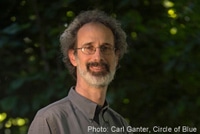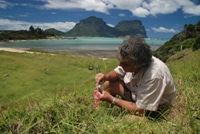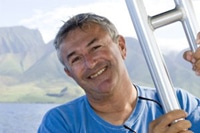Jane Goodall Brings Message of Hope
From UpStream Newsletter, Fall 2003
A crescendoing hoo-hoo-hoo-hoo-hoo sounded eerily through the hushed crowd
packed into Longwood Gardens’ tented auditorium.
Suddenly, seemingly out of nowhere, a slight woman appeared behind the lectern
on the stage, her lips pursed like the chimpanzees she was mimicking.
Thus the crowd met Jane Goodall, the speaker at a special presentation of the Joan M. Stroud Memorial Lecture, called “The Water’s Edge.”
Few of the guests who attended the October 3 lecture and the dinner that followed
will forget the evening. But for the 130-plus children who sat entranced for an hour on a hardwood floor earlier in the day, “Dr. Jane’s” chimp calls and vivid descriptions of life among our closest living relatives was an experience of a lifetime. She opened her talk to the children with international greetings, “Good morning,” “Bonjour,” “Guten Tag” and “Hoo-hoohoo-hoo,” to the delight of her responsive audience which echoed her salutations in all four languages.
She told the enthralled gathering – mostly members of local groups of the international Roots & Shoots organization Dr. Goodall founded – how as a young girl she had dreamed of going to Africa. Her hero was Tarzan, she said, and she gladly would have swapped places with her namesake, “that wimpy Jane.”
She also spoke of the early influence of Doctor Dolittle, an eccentric country doctor who loved animals and learned to speak their language. The Doctor Dolittle stories originated as letters Hugh Lofting wrote home to his children while he was serving in World War I. (Later, Hugh Lofting’s great-granddaughter Claire Murray, who is actively involved as a volunteer for the Stroud Center and lives just up the road, gave Dr. Goodall an original copy of “Doctor Dolittle’s Post Office.”)
At Dr. Goodall’s invitation, representatives of the four local Roots & Shoots groups reported on their activities.
Afterwards Dr. Goodall and her young audience went outside for a group photo.
Clearly she was among her most ardent fans. Many crowded around and asked for her
autograph, while some just wanted to meet their heroine.
One girl, clutching a chimp doll in her arms, was so overcome she burst into tears when Dr. Goodall left the children to speak to reporters. A parent later brought the still sobbing Abi Riley to Dr. Goodall, who immediately hugged and comforted her with words and a tissue. Abi’s tears quickly turned into smiles.
Dr. Goodall has strengthened her outreach to children even more since she founded
Roots & Shoots, a program for young people from kindergarten to university that encourages local action, care for the environment and animals, and peace. She noted several times at her Stroud Center appearances that the growth of Roots & Shoots, which started in Tanzania in 1991, had swelled after the Word Trade Center bombing on September 11, 2001. There are now over 3,000 branches throughout the United States and in 70 other nations.
‘Chimps Are So Like Us’
The story of how a poor girl from London managed to find her way to Africa and into the lives of chimpanzees is now part of popular history, documented in books and films. And her studies have helped change the definition of humanity.
“Most fascinating is how chimpanzees are so like us,” she told the evening crowd at the Water’s Edge. There is only a “one-percent difference” between the DNA structure of a chimp and human, she said. A chimp’s blood is interchangeable with a human’s, and its brain structure is closer to that of a human than any other animal. Like humans, chimp mothers keep their babies close to them for years.
But, she added grimly, “Chimps have got a dark and brutal aggressive side; they do show primitive warfare. The sad thing is that when I first learned about that I realized they were more like us than I had thought before.”
At age 69, Jane Goodall now spends 300 days of the year traveling about the
world, spreading her message of peace, environmental and social responsibility,
and hope to general audiences, organizations, officials and heads of states – and to children.
Next year, on Peace Day, September 21, “we shall have children ringing the bells of peace and giant peace doves spreading their wings,” she said. The bells, she added, will be made from melted down weapons of war.
She hopes the action will help generate a feeling around the world that is different from fear – that is hope and peace. “Hope for the future,” she said. “Hope for the involvement of every single one of us in doing our bit to make sure the right people are elected, to make sure we live in harmony with the environment, to make sure we help the environment, and above all to give the right example and leadership to our children.”
Visiting the Labs
During the morning of October 3 Dr. Goodall spent several hours at the Stroud
Center, speaking with the scientists and touring the laboratories. “She was so genuine and engaging,” said Stroud Center Director Bernard Sweeney. “It’s incredible to think of what she’s done. One feels a little shallow when you’re with someone like Jane Goodall.”
“But we have something in common,” he added. “We [the Stroud Center and Dr. Goodall] are both about trying to make the world a better place.”



